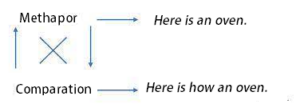
Living metaphor and narrative
Both are themes of Paul Ricoeur, but establishing a clear connection between these two concepts is no simple task, the author himself will not say between metaphor and narrative, there is such a concept.
connection between these two concepts is no simple task, the author himself will not say between metaphor and narrative, there is such a concept.
This is because, as we have already found in a previous post, it is almost a refoundation of eidos (what was an idea for the Greeks), giving it (the metaphor) an “ideology of the ineffable”, which is nevertheless attainable since it is in the consciousness as an unspoken.
Also in this post we emphasize that living metaphor starts where linguistics ends, and narrative is in close connection with linguistics, but it would be bold to say that narrative is not also a form of metaphor, so in this unexpected intersection between narrative where metaphor lives .
Metaphor in the reading of the Greeks, in Aristotle’s poetics and rhetoric, the word or name are basic units between poetics and rhetoric, while the second is more focused on mimesis.
The idea that language has a function other than the conventional one, was defended by Heidegger saying that it has this other function is poetics, and it refers us both to metaphor and other figures of speech that are beyond the so-called “poetic license”, for it has a rhetorical function.
It is found in the current definition of metaphor as that figure of speech in which an implicit comparison is verified, but what is the relationship between a comparison and metaphor?
Ricoeur clarifies that at the core of this relationship, there is “a small enigma” in the Aristotelian discourse, at the origin of this question, “because this treatise (of Rhetoric), which claims to add nothing to the definition of metaphor given by Poetics, in chapter IV draws a parallel no counterpart in this last treatise, between metaphor and comparison?” (Ricoeur, 2005, p. 42).
Ricoeur’s first response is that it depends “within the Aristotelian corpus” (p. 42), but he will object to the purpose that is not explicit, “Aristotle points out the subordination of comparison to metaphor”, so “it is not to explain here metaphor through comparison, but rather comparison through metaphor” (p. 43).
This enigma becomes the theory of metaphor-statement in Paul Ricoeur, more than a rich figure of speech, it is broken down into two parts: “under the name of ‘parabole’, it is linked to the theory of ‘proof’ (Book I of Rhetoric), which consists of illustration by example, which subdivides, in turn, into historical or fictitious example; the other, under the name of eikon, is linked to the theory of lexis and placed in the domain of metaphor” (p. 44).
The resources and arguments of living metaphor allow us not only to understand the narratives, but also to penetrate their constitutive elements as resources of language and knowledge.
RICOEUR, P. Metáfora Viva. Living Metaphor. Brazil, São Paulo, trans. Dion David Macedo. 2nd ed., Ed. Loyola. 2005.









